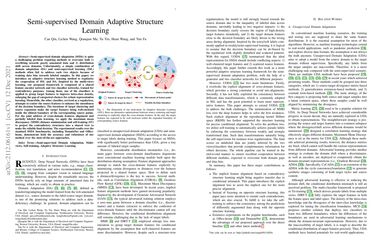Semi-supervised Domain Adaptive Structure Learning
Semi-supervised domain adaptation (SSDA) is quite a challenging problem requiring methods to overcome both 1) overfitting towards poorly annotated data and 2) distribution shift across domains. Unfortunately, a simple combination of domain adaptation (DA) and semi-supervised learning (SSL) methods often fail to address such two objects because of training data bias towards labeled samples. In this paper, we introduce an adaptive structure learning method to regularize the cooperation of SSL and DA. Inspired by the multi-views learning, our proposed framework is composed of a shared feature encoder network and two classifier networks, trained for contradictory purposes. Among them, one of the classifiers is applied to group target features to improve intra-class density, enlarging the gap of categorical clusters for robust representation learning. Meanwhile, the other classifier, serviced as a regularizer, attempts to scatter the source features to enhance the smoothness of the decision boundary. The iterations of target clustering and source expansion make the target features being well-enclosed inside the dilated boundary of the corresponding source points. For the joint address of cross-domain features alignment and partially labeled data learning, we apply the maximum mean discrepancy (MMD) distance minimization and self-training (ST) to project the contradictory structures into a shared view to make the reliable final decision. The experimental results over the standard SSDA benchmarks, including DomainNet and Office-home, demonstrate both the accuracy and robustness of our method over the state-of-the-art approaches.
PDF Abstract




 Office-Home
Office-Home
 DomainNet
DomainNet